Paul Gilster's Blog, page 240
October 1, 2012
SPACE: A Personal Vision
by Shen Ge
Coming up this January is a two-week long “minds-on ties-off” research workshop at Callao Salvaje on Tenerife on the Canary Islands. I learned about the organization behind the workshop — the Scientific Preparatory Academy for Cosmic Explorers — in Houston when I had the good fortune to have dinner with its young co-founder Shen Ge. Shen’s organization is a nonprofit academic and research corporation created by young people from many countries. It began this year with a July conference on the Isle of Man, and will soon enter what it considers Phase 1: Building educational modules for brief space courses that can be taught at the university level. The ultimate goal is an actual university with full-time faculty and students. I asked the energetic Shen if he could supply us with a brief article outlining his vision and the steps ahead.
In some respects, Shen’s ideas parallel those of the International Space University, as he notes below, although he hopes to extend their reach. The ISU is a non-profit institution offering graduate-level training from a central campus in Strasbourg, France, with a two-month Space Studies Program and a one-year Masters program covering space programs and enterprises, space science, space engineering, systems engineering, space policy and law, business and management, and space and society. More than 3300 students from 100 countries have had ISU training, developing a network of space professionals that Shen hopes to enrich and extend.
I’ve recently been asked to comment on my vision for our Scientific Preparatory Academy for Cosmic Explorers, or SPACE, an organization of which I am a co-founder. There currently exists no such entity as SPACE in the world and there needs to be if humanity is ever to become a spacefaring civilization. My vision is of an international, interdisciplinary, and hands-on research and educational university where anyone with a passion for space and a decent academic record will be welcomed to join our institution to learn and research space topics.

From recent surges in space development, whether they are publicly funded by governments in rapidly developing nations such as China or India aiming for prowess or whether they are started by young upstarts backed by wealthy entrepreneurs such as Planetary Resources or Space X aiming for profits, there is no denying that space will play a vitally important role for all of us on Earth. Just as we cannot imagine today a world without airplanes flying people everywhere for business or leisure, in the next few decades we will live in a world where we could not imagine people not taking space trips to space colonies, the asteroids or the Moon.
Yet for us to reach that point, we need more people with both the knowledge and interest in a discipline that can propel humanity into a spacefaring civilization. When I look back at my own experience, I’m a little disappointed. I obtained a good education in aerospace engineering but I found three important areas missing in my programs:
1) No core focus on space. This is completely understandable since aerospace engineering also delves deeply into aircraft. There currently exists no multidisciplinary space educational university for the undergraduate. There are aerospace engineering programs around the world but many of them are not related to space or are heavily specialized in one area.
2) Lack of other classes related to space that were not engineering-oriented. Many new discoveries are made from cross-disciplinary studies. Yet at engineering schools, we are required to take so many engineering classes that we inevitably cannot learn much of other interesting fields. We are advocating a multidisciplinary space education that includes topics such as astronomy, astrophysics, computer science, astrophysics, space law, space commerce etc. in a 4-year educational curriculum.
3) Lack of research opportunities directly related to space. Unless the student lands an internship or enters a co-op working for a space company, actual space research is limited to a handful of professors. And as mentioned above, much of the research actually being performed in the aerospace engineering department is still geared towards aircraft. We seek research that emphasizes the skills and knowledge needed by those who will explore the cosmos.
The International Space University (ISU) is a needed step towards creating an educational entity that revolves around space and offers more than a single discipline such as aerospace engineering can provide. Conversations among ISU professors and alumni such as Christopher Stott, Chris Welch, Adil Jafry, and Virgiliu Pop helped all of us realize that even ISU is missing something. It is missing the educational pipeline that lies before it. The people who seek to go into ISU have already obtained at least a 4-year education elsewhere, often in a field not related to space.
We decided with the understanding support from ISU personnel that the establishment of SPACE will substantially complement the established ISU. Our goal: To build an international space academy that will complement the existing International Space University (ISU) by providing a four-year university of space studies. This will endow the people with the skills and mentality to go to the stars and go there to stay.
In my vision, I see the next five years for SPACE as an arduous path of overcoming initial skepticism and establishing our dream in physical reality. Chris Welch affectionately called us “Dreamers 3.0” (ISU was co-founded by Dreamers 2.0) at his presentation at our inaugural conference earlier this July [2012] but I would like to say that we’re more than “Dreamers.” We are “Do-ers” as well.
We lack tens of million dollars to build our institution (although we would certainly be glad for the help of any rich benefactors to our cause). Hence, we are building up our reputation via events such as the upcoming January SPACE Retreat on Tenerife, our annual conference in July, and our upcoming educational modules to teach our space design and sociology courses at universities around the world. We are concurrently conducting research on asteroid mitigation, space imaging, and space trajectories for which we will publish papers and present at conferences.
Through our activities as “Do-ers 3.0,” I see enough attention drawn to our cause in the next five years from both the wealthy and the population at large that we will be able to secure the funds needed to build our campus and research buildings here on Earth. Hopefully, in my lifetime, we will have satellite campuses on space stations in orbit, on asteroids, and on the Moon as well. Our fundamental thesis is that exploration is education, and that scholarly instruction and research are merely two aspects of discovery. The ultimate goal of SPACE is to help build a space-faring society.






September 28, 2012
Lowering Life’s Chances on Super-Earths
Super-Earths are exciting finds. The more of them we discover, the more likely it seems that life is abundant in the cosmos. But new work examining the viscosity and melting temperature of mantle rock is casting a different aura over super-Earths. Rather than being planets much like the Earth but simply more massive — worlds characterized by thick atmospheres, plate tectonics, volcanic activity and magnetic fields — they may differ in fundamental ways. With internal pressures tens of times higher than those found in Earth’s interior, large viscosities and melting temperatures could have adverse consequences on the planet’s habitability.
The potential effects extend as far as the core of the planet, which may not even exist. In a presentation at the European Planetary Science Congress on September 26, Vlada Stamenkovic (Massachusetts Institute of Technology) noted that the average super-Earth may in fact be undifferentiated; i.e., it may not have separated into a metallic core and a rocky mantle:
“Current understanding is that the terrestrial planets in our solar system formed rapidly — in about the first 50 million years. The time scale of core formation depends strongly on viscosity. The high melting temperatures and the large viscosities that we’ve calculated for super-Earths suggest either a slow core formation or no core formation at all. This raises doubts about whether super-Earths could generate magnetic fields.”
Without a liquid metallic core, a magnetic field that could play a role in protecting the atmosphere from solar particles would be unlikely. Moreover, plate tectonics are not inevitable on a super-Earth, a phenomenon that, along with volcanic activity, can play a role in regulating the climate during ice ages. Stamenkovic and team are looking at the effect of volcanic outgassing and the production of molten rock, which they believe decline with increasing planetary mass.
“Our work highlights the importance of understanding the thermal evolution of planets — moreover, it shows that super-Earths are more diverse than expected. We will only be able to fully answer questions by gathering more data from high-pressure experiments and from spectroscopic observations of super-Earth atmospheres orbiting close-by bright stars. Theory shows the possibilities, which are far larger than previously thought, but remains full of uncertainties,” said Stamenkovic.
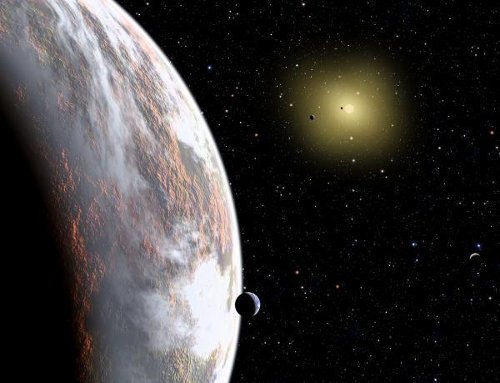
Image: A super-Earth like the one in this artist’s conception can grow twice as large as Earth with up to 10 times the mass. But would its thermal evolution make it a likely candidate for life? Credit: David A. Aguilar (Harvard-Smithsonian/CfA).
Even in a differentiated super-Earth, the researchers found that heat flow from the core can be limited by stagnant layers forming deep in the mantle, with conduction instead of convection becoming the primary form of heat transport, which would reduce the cooling rate of the core. We lack the data to make the call, but easy assumptions about super-Earths and habitability now have to contend with robust alternative scenarios.
Two papers coming out of this work are available: Stamenkovic, et al., “The influence of pressure-dependent viscosity on the thermal evolution of super-Earths,” Astrophysical Journal, 748:41 (20 March 2012) and Stamenkovic et al., “Thermal and transport properties of mantle rock at high pressure: Applications to super-Earths,” Icarus 216 (2011), 572-596. More in this European Planetary Science Congress news release.






September 27, 2012
Pluto, Charon and Kepler
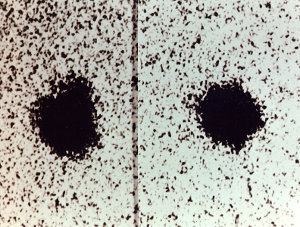
Our view of Pluto/Charon gets better and better as we prepare for the New Horizons flyby in 2015. It wasn’t so long ago that we had no idea Pluto had a single moon, much less the five we have so far identified. When James Christy (USNO) discovered Charon in 1978, he was looking at photographic plates of Pluto that showed little more than a slight bulge that appeared periodically. The bulge came into and out of view as the [dwarf] planet rotated, indicating a genuine object and not a flaw in the observation, but although Charon had been found, we couldn’t resolve separate disks until the Hubble Space Telescope’s images of the 1990s.
Image: Plates taken with the Kaj Strand Astrometric Reflector at the USNO Flagstaff Station in Arizona revealed the existence of Charon, visible as an elongation in the image. Later eclipses and occultations of Pluto and Charon confirmed the discovery. Charon has a mass of about 22 percent that of Pluto. Credit: Wikimedia Commons.
The Hubble images, unlimited by distortions from Earth’s atmosphere, have revealed much about Pluto/Charon. But take a look at another image, this one taken with the Gemini North 8-meter instrument. This is said to be the sharpest ground-based imagery of Pluto/Charon ever taken in visible light. These observations have not only verified the orbital characteristics of the two objects but are sharp enough to reveal their precise diameters. Steve Howell (NASA Ames), who led the study, says “The Pluto-Charon result is of timely interest to those of us wanting to understand the orbital dynamics of this pair for the 2015 encounter by NASA’s New Horizons spacecraft.”
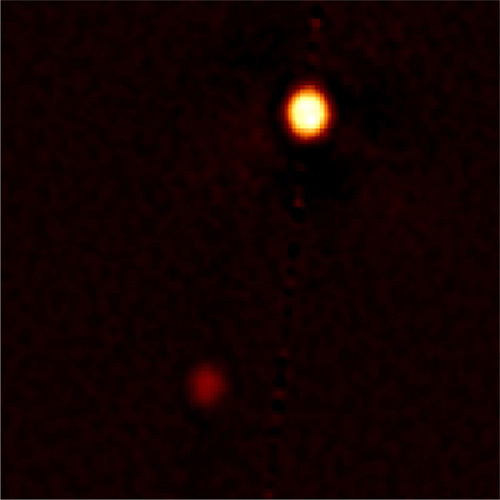
The technique being used here is called reconstructive speckle imaging, made possible through mounting a camera called the Differential Speckle Survey Instrument (DSSI) onto the telescope. Using these methods, a large number of short exposure images are processed to remove the effects of atmospheric distortion. Each image was exposed for 60 milliseconds. Over the range of images, the light from the objects under observation could be separated from the transient artifacts caused by the atmosphere. The DSSI instrument and associated software were created by Elliott Horch (Southern Connecticut State University) and team in 2007. Detectors for the instrument were upgraded in late 2009, making possible the new levels of sensitivity shown here.
Image: Speckle image reconstruction of Pluto and Charon obtained in visible light at 692 nanometers (red) with the Gemini North 8-meter telescope using the Differential Speckle Survey Instrument (DSSI). Resolution of the image is about 20 milliarcseconds rms [root mean square]. This is the first speckle reconstructed image for Pluto and Charon from which astronomers obtained not only the separation and position angle for Charon, but also the diameters of the two bodies. North is up, east is to the left, and the image section shown here is 1.39 arcseconds across. Credit: Gemini Observatory/NSF/NASA/AURA.
Reconstructive speckle imaging is showing its stuff with Pluto/Charon, but the bigger picture is that the upgraded DSSI can be used in the exoplanet hunt. Kepler’s transit studies require follow-ups from other instruments to confirm the discoveries, and the original DSSI had been in use at Kitt Peak for this purpose. NASA’s Howell says that speckle imaging with the Gemini telescope will double the instrument’s ability to resolve objects, offering a 3- to 4- magnitude sensitivity increase for the sources the team needs to observe. The astronomer calls it “an enormous gain in the effort underway to confirm small Earth-size planets.”






September 26, 2012
Life-Bearing Rocks in Slow Motion
I’ve been fascinated with Edward Belbruno’s work on ‘chaotic orbits’ ever since meeting him at an astrodynamics conference in Princeton some years back. The idea is to develop low-energy routes for spacecraft by analyzing so-called ‘weak stability boundaries,’ regions where motion is highly sensitive and small changes can create gradual orbital change. A low-energy route was what Belbruno used in 1991 to help the Japanese spacecraft Hiten reach the Moon using almost no fuel, a proof of concept about which the physicist said “It saved the spacecraft, and it saved my career.”

That comment came from a lecture to the Mathematical Association of America in 2009 that you can listen to here. It’s fascinating in its own right, but doubly so since Belbruno is back in the news with new findings on the idea of panspermia, and specifically that version of panspermia called lithopanspermia. In this hypothesis, elemental life forms are distributed between stars in planetary fragments created by asteroid impacts, volcanic eruptions and other disruptive events. Drifting through space, the fragments are eventually caught in another solar system’s gravity, some of them conceivably falling on worlds in the habitable zone of their star.
Image: The Sun is thought to have formed in a cluster of other stars around 4.5 billion years ago. Newly born star clusters like Pismis 24 (pictured) may be similar to the environment in which the Sun spent in its early years. Much closer to its neighbours than it is now, the nascent Solar System probably exchanged material with other planetary systems, and it is possible that early life could have spread between these neighbouring planetary systems. Credit: NASA, ESA and Jesús Maíz Apellániz (Instituto de Astrofísica de Andalucía, Spain).
Could something like this have caused life to begin on Earth? Belbruno’s work, with Amaya Moro-Martín (Centro de Astrobiología and Princeton University) and Renu Malhotra (University of Arizona) simulates conditions when the Sun was young and still a part of the cluster that gave it birth. Using simulations performed by Princeton graduate student Dmitry Savransky, the researchers applied the theory behind chaotic orbits and in particular the idea of ‘weak transfer,’ which they believe offers rocky fragments moving at low velocities a high probability of moving between close stars. In fact, they believe our system could have exchanged materials with its nearest planetary system neighbor 100 trillion times before the Sun left its native cluster.
“The conclusion from our work,” Moro-Martín says, “is that the weak transfer mechanism makes lithopanspermia a viable hypothesis because it would have allowed large quantities of solid material to be exchanged between planetary systems, and involves timescales that could potentially allow the survival of microorganisms embedded in large boulders.”
Moro-Martin adds that the work does not prove lithopanspermia actually happened, but indicates it is an open possibility, with further study needed into the question of rocky materials landing on a terrestrial planet. Could life have arisen on Earth before the dispersal of the cluster? The authors believe that it could, assuming life arose shortly after there is evidence of liquid water on its crust. From the paper on this work:
Within this timeframe, there was a mechanism that allowed large quantities of rocks to be ejected from the Earth: the ejection of material resulting from the impacts at Earth during the heavy bombardment of the inner solar system. This bombardment period lasted from the end of the planet accretion phase until the end of the LHB 3.8 Ga, i.e. it finished when the solar system was approximately 770 Myr old (Tera et al. 1974; Mojzsis et al. 2001; Strom et al. 2005). It represents evidence that planetesimals were being cleared from the solar system several hundred million years after planet formation (Strom et al. 2005; Tsiganis et al. 2005; Chapman et al. 2007). This period of massive bombardment and planetesimal clearing encompassed completely the “window of opportunity” for the transfer of life-bearing rocks discussed above and therefore provides a viable ejection mechanism that may have led to weak transfer.
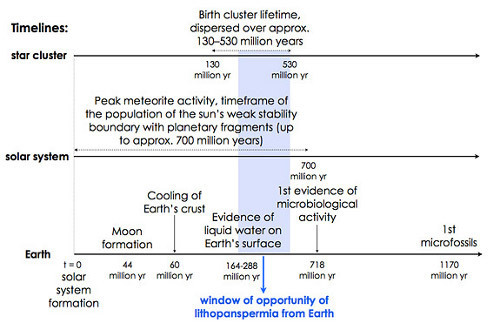
Image: The researchers suggest that ideal conditions for lithopanspermia in the sun’s birth cluster, in the solar system and on Earth overlapped for several hundred million years (blue shaded area). Rock evidence suggests that the Earth (bottom line) contained surface water during a period when the relative velocities between the sun and its closest cluster neighbors (top line) were small enough to allow weak transfer to other planetary systems, and when the solar system (middle line) experienced high meteorite activity within the sun’s weak gravitational boundary. If life arose on Earth shortly after surface water was available, life could have journeyed from Earth to another habitable world during this time, or vice versa if life had an early start in another planetary system. Credit: Amaya Moro-Martín.
Back in 2005, David Spergel (Princeton) and Fred Adams (University of Michigan) studied binary stars in young clusters. They found that the chances of life-bearing rocks being exchanged between star systems ranged from one in a million to one in a thousand, depending on the scenario invoked. Of the new work, Adams says:
“This paper takes the type of calculations that have been done before and makes an important generalization of previous work. Their work on chaos in this context also carries the subject forward. They make a careful assessment of a process that is dynamically quite complicated and chaotic in nature. They are breaking new ground from the viewpoint of dynamical astrophysics. Regarding the problem of lithopanspermia, this type of weak capture and weak escape is interesting because it allows for the ejection speeds to be small, and these slow speeds allow for higher probabilities of rock capture. To say it another way, chaos, in part, enhances the prospects for lithopanspermia.”
The paper is Belbruno et al., “Chaotic Exchange of Solid Material between Planetary Systems: Implications for Lithopanspermia,” published September 12 in Astrobiology (preprint). The Spergel and Adams paper is “Lithopanspermia in Star Forming Clusters,” Astrobiology Vol. 5, No. 4 (2005). Preprint available. This Princeton news release contains details about the simulations used in the Belbruno study.






September 25, 2012
The Billion Year Plan
At the 100 Year Starship Symposium in Houson, I sent out a large number of tweets as @centauri_dreams. That Twitter account is still live, but be aware that my son Miles, who is now working actively with us, has set up a new account solely for the Tau Zero Foundation. You can access @TZFoundation to pick up interesting links and news of the interstellar community. I suspect, for example, that when Miles runs across articles like the one I’m going to be discussing today, they’ll appear on Twitter, but he’s bound to find a lot of good material that I miss.
Yesterday we were looking at distance issues as Larry Klaes discussed the extension of Ithaca, NY’s Sagan Planet Walk all the way to Hawaii, where a new ‘station’ represents Alpha Centauri. Matters of scale are important to convey to the public because getting across the distances involved in interstellar flight is tricky, and various ways of modeling them can provide the needed perspective. Peter Garretson thinks about scale as well, but in What Our Civilization Needs Is a Billion Year Plan, a new piece on the Kurzweil Accelerating Intelligence blog, he attacks the issue in terms of time. And actually he ranges a good deal beyond the billion years mentioned in the title.
Lt. Col. Garretson has been thinking about futuristic issues for a long time. He’s a space advocate who serves as Chief of Future Science and Technology Exploration for Headquarters Air Force, a man who has written widely on issues ranging from planetary defense to space solar power, and in a number of white papers he has discussed investment strategies for high risk/high return technologies and lunar development. In the Kurzweil piece, he picks up on a presentation originally made at the International Space Development Conference last year.
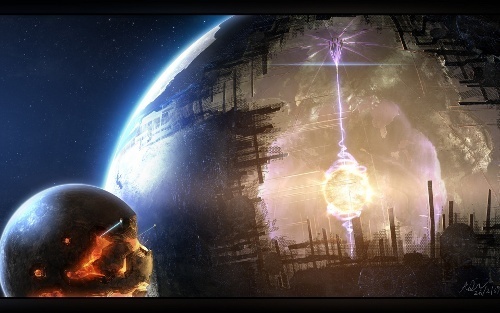
Image: An imagined far future as a Kardashev Type II civilization exploits its system to enclose its star in a Dyson sphere. Credit: Adam Burn.
Usually when I talk about a ‘long-term’ strategy, I’m looking centuries and conceivably a millennium ahead, but Garretson takes us to the death of the Sun and beyond. And in the interim, he’s suggesting that we should be planning for a future in space that begins with O’Neill-style space colonies constructed out of materials in the asteroid belt, ultimately enough to support between 10 and 100 trillion humans (links to the sources for these numbers are provided in the text). Key to the short-term plan, which could itself take centuries, is the need for energy. He considers fossil fuels a kind of ‘baby fat’ for the Earth to use in growing to adolescence, saying that spacefaring and new energy sources will have to be developed before we run out of this ‘easy’ energy and lose the energy capital we need to create the crucial precursor technologies.
Even so, abundant future energy doesn’t mean we can stay on Earth forever:
The case where we transcend a fossil fuel crisis is just as compelling. If we succeed in continuing our population and development growth and find new energy sources, and assuming energy use (including all sources: fossil, nuclear, fusion, etc.) grows at annual rate of 2.3% (reduced from the current 2.9% to be more realistic), we’d only be able to continue growth on Earth for another 420 years before we could not maintain the heat balance of the planet, and started boiling the oceans ourselves.
Imagine a future Earth ringed by solar power satellites maintaining a population of some 10 billion or so in relative prosperity, its needs met by 40-50 TW of total electrical energy. It could be a green and prosperous place, but the vision Garretson suggests is of a place that might quickly become something of a backwater as a spacefaring civilization grows up to 10,000 times more populous. This is a lively essay, profusely illustrated, pointing ahead to Kardashev Type 2 — where the total energy of the Sun could be exploited — and into a still more speculative future beyond.
Interstellar flight plays a major role in Garretson scenarios, and he’s generous in mentioning not only our Frontiers of Propulsion Science text (edited by Marc Millis and Eric Davis and published by the AIAA in 2009), but also the 100 Year Starship organization, the prior work of the Breakthrough Propulsion Physics project run by Millis at Glenn Research Center in Cleveland, and the Tau Zero Foundation. Icarus Interstellar should make an appearance here as well, and I suspect a future iteration of this presentation will include the ongoing re-design of the British Interplanetary Society’s Daedalus starship, now under the capable leadership of Pat Galea.
I won’t go through all the future possibilities Garretson examines — you’ll want to read the essay yourself, where you’ll find speculations going as far ahead as the ‘degenerate era’ some 1014 to 1040 years from now. But drivers for a bolder space program in our own time also make an appearance, including severe damage and even mass extinctions caused by asteroids. An asteroid mining infrastructure, which we may be seeing the first steps toward through organizations like Planetary Resources, will ultimately develop the best methods for asteroid deflection, an early priority for a civilization spreading out into the Solar System.
Along the way there is a healthy jolt of inspiration:
Many look at the significant events discussed above as “doomsday scenarios,” but to me, they are just eventualities to be planned for, and chance favors the prepared mind. It’s also a happy consequence that the farther out you look for problems, and the bigger problems you try to tackle, the more likely you are to perceive and be able to bring ambitious thinking to more proximate problems.
If we had not been building instruments in space to look far out into space, we would not even know about the threats of asteroids, comets, gamma-ray-bursts or galactic collisions. We also would not have the space-based surveillance to know about the hurricane or tsunami on its way. Lifting our eyes to the horizon pays.
Of course, there are more proximate threats, and several of our own creation. But personally, I bet on humanity, not against humanity. We are the life carriers, the intelligence, and the gametes of Gaia. It is our destiny to spread not just human life, but the entire clan of life, and intelligence, first to the Solar System, and then to the stars.
Garretson is a man of sweeping concepts, and in that sense he picks up on the same kind of optimism about space that used to infuse our culture in the period before the first moon landings, the breathtaking notions that Chesley Bonestell illustrated for Collier’s and Wernher von Braun advanced as what seemed to be a sure path to Mars. Much has changed in the days since, but we need the deeply imaginative vision to reawaken a public sense of awe over our possibilities in the cosmos. All this is a tough sell in our time, but Garretson knows it’s worth trying. Being bold can help open minds and launch careers that will matter down the line.






September 24, 2012
To Alpha Centauri via Hawai’i
I’m always looking for ways to relate interstellar distances to common objects on Earth, knowing that misunderstandings about the vast scale of the universe are common. Sir John Herschel (1792-1871) talked about dropping a pea off the side of a ship after every mile on an ocean voyage the distance of the nearest star, telling his readers that it would require ‘a fleet of 10,000 ships of 600 tons burthen, each starting with a full cargo of peas.’ Herschel was the first to try to measure the distance to Alpha Centauri, and while his numbers weren’t as accurate as ours, he captured for his era the disconnect between Earthly distances and the heavens. Larry Klaes weighs in this morning with yet another way to study the issue, using an exhibition on the interplanetary scale that has now been extended Herschel-style to the ultimate voyage.
By Larry Klaes
Since its dedication in 1997, the Sagan Planet Walk has become a landmark feature of downtown Ithaca, New York. The various monuments, or “stations”, representing the major places in the Solar System from the Sun to Pluto serve first as a memorial to the late Cornell astronomer and science popularizer Carl Sagan. Perhaps best known for his Cosmos television series which premiered on PBS in 1980, Sagan passed away in December of 1996 at the age of 62 after two decades of teaching at the university.

The Sagan Planet Walk also serves as a continuing educational tool about our celestial neighborhood. Among its astronomy informational features is the Walk’s physical demonstration of just how far apart objects in our Solar System really are on a scale that the general public can relate to. When reduced from its actual radius of five billion miles, the Solar System’s scale becomes clear in everyday terms. The gray marble Sun station resides prominently in the Ithaca Commons with the planets from Mercury to Mars nearby, while the Pluto station sits just outside the Ithaca Sciencenter nearly one mile away. The Sciencenter is the primary developer of the Sagan Planet Walk.
One question that has often been asked by folks who hiked the Sagan Planet Walk is just how far away the stars nearest to our Sun would be on this scale. The answer is that a station for this feature of the Walk would have to be located in tropical Hawai’i over five thousands miles west of temperate Ithaca. That is how far one would have to travel to reach the representation of our nearest suns, the Alpha Centauri system, which exists 4.3 light years away, or over 25 trillion miles across interstellar space.
Image: The beginning of the Sagan Planet Walk, a gray marble monument symbolizing the Sun. Bring your walking shoes if you’re headed for the Pluto station. Alpha Centauri will require plane tickets. Credit: Andrew Alden.
For the last two years, the Sciencenter has been partnering with Cornell, the University of Hawai’i, and NASA to place an Alpha Centauri station on the Big Island of Hawai‛i at the ‘Imiloa Astronomy Center on the Hilo campus of the University of Hawai‛i. Lead funding was provided by the NASA Space Grant Program of New York (based at Cornell) and Hawai‛i (based at the University of Hawai‛i), with additional major funding provided by ‛Imiloa and the Sciencenter.
A dedication ceremony to mark this newest and most distant addition to the Sagan Planet Walk will be held on September 28 at the ‘Imiloa Astronomy Center to coincide with the annual Polynesian Voyaging Festival at the hands-on science center, which focuses on astronomy and the culture of Polynesian voyaging. The features of the festival are to include presentations of double-hulled, ocean-going canoes, live demonstrations, and other activities that celebrate the proud heritage associated with centuries of Pacific Ocean crossings without instruments. Among those present at the dedication will be Charlie Trautmann, executive director of the Sciencenter and adjunct professor of engineering at Cornell.
While retaining the basic features common to all the stations of the Sagan Planet Walk – placards with interesting facts and a proportional model of each world that invites visitors “to contemplate the enormous, awe-inspiring scale of the Universe and our place within it” – the Alpha Centauri station also reflects the culture of its surroundings (Kamailehope is the Hawaiian name for Alpha Centauri).
The centerpiece of the exhibition is a large stone Hawaiian figure, sculpted in native Hawaiian volcanic stone by world-renowned Hawaiian artist Rocky Jensen. On either side of this sculpture are four graphic panels which detail the scale of the Solar System in both English and Hawaiian, the connection with the Sagan Planet Walk in Ithaca, and how the Alpha Centauri stars were utilized by Polynesian sailors to cross the Pacific in their open, double-hulled canoes without the need for astronomical tools. Native Hawaiian school children will learn about their heritage and the history of navigation thanks to an eight-foot wide circular star compass which completes the station.
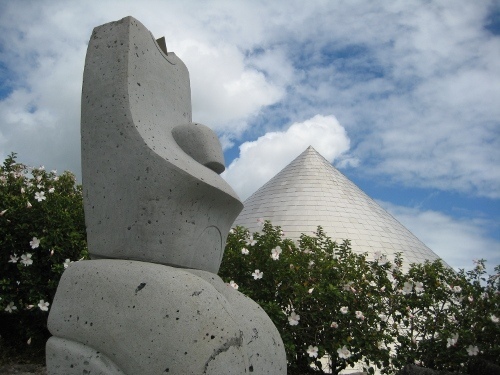
Image: The Alpha Centauri station of the Sagan Planet Walk, fittingly found under Polynesian skies. Credit: Ithaca Sciencenter.
“The inclusion of the Alpha Centauri station has been fifteen years in the making, so we’re excited to see it coming to fruition and completing the Sagan Planet Walk,” said Teresa Smith, Public and Media Relations Manager at the Sciencenter.
The day after the Hawai’i dedication ceremony, the Sciencenter will hold its own celebration of the Sagan Planet Walk expansion to our nearest stellar neighbors by offering a free tour of the Walk, guided by Greg Sloan of Cornell’s Astronomy Department. Tour members will meet up at the Sun station on the Commons and make their way through the Solar System to the Pluto station at the Sciencenter, where prepared Hawaiian refreshments will await.
The newly expanded Sagan Planet Walk is now the largest such exhibition on Earth, measuring five thousand miles from end to end. This eclipses the previous record of 66 miles held by the artwork in the Stockholm, Sweden subway tunnels.






September 21, 2012
Keeping the Worldship Alive
One of the challenges of explaining why a starship project is worth doing even though its final goal may not be realized for a long time is in showing how this work can have an impact on improving things on Earth. Technological spinoffs have acquired a bad name because of the stigma of Teflon and Tang — NASA hasn’t made the strongest case for how advanced work changes lives (and in any case, Teflon and Tang are not actually NASA spinoffs, though they are in the eyes of the public). But work in space can effect profound changes on Earth, and there is every reason to believe that energy breakthroughs in propulsion and power generation could be highly useful in solving our planet’s future energy demands. [See the comments for a recent change to this text].
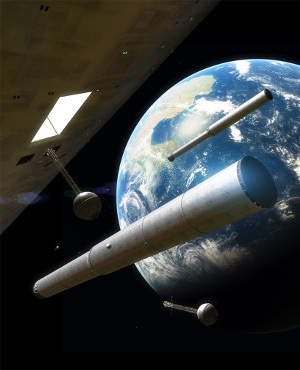
The list can obviously be expanded, as in the case of closed ecologies, which we’ve been talking about recently in these pages. A long-duration human mission demands attention to environments and their maintenance that will surely tell us much about preserving Earth’s ecosystems. Now I see that Rachel Armstrong, who works on sustainable environmental solutions using synthetic biology, is developing Project Persephone, an Icarus Interstellar initiative for the 100 Year Starship effort that looks at starship architecture and how it can best protect its inhabitants.
Armstrong is a TED Fellow whose work is multidisciplinary to the core. Indeed, it’s her view that “Scientists need to work outside their own areas of expertise to make new technologies that are pertinent to the 21st century and to collaborate, both with other scientific disciplines and the arts and humanities.” Synthetic biology can be considered the engineering of living systems. In an article for Discovery News, Armstrong explains that a ‘worldship’ — a vast craft that might take centuries or more to carry a human population to the stars — will need to behave as a supple and evolving ecology rather than as the kind of mechanistic system found in modern cities today.
Image: A worldship conceived as a vast cylinder, housing a self-contained ecology that may have to survive for centuries if not longer. A new project examines synthetic biology and sustainable architectures for such an effort. Credit: Adrian Mann.
That means thinking creatively about what the kind of materials we build with and what we ask them to do. Inert materials and industrial methods are what we are familiar with, but it’s Armstrong’s view that these practices create barriers rather than connections:
Perhaps it is possible to use the innate “force” of different kinds of materials to create an artificial nature, which can shape streams of material flow to create a living interior that is capable of regeneration and is not simply waiting to be consumed by its human colony. A material ecology may be feasible if the worldship itself was able to provide an external source of energy, so that the living interior would not be a closed system, but open — as if it had its own (nuclear) sun.
Just as metamaterials hold out the prospect of cheaper and lighter manufacture of large objects like telescope mirrors, synthetic biology may help us work with and adjust the numerous interactions that make up the support structure for a functioning community. Armstrong points to possibilities like using artificial soils and terrestrial micro-biota to seed a worldship’s ecology. Project Persephone will develop technical models that explore such systems and the infrastructures to support them.
Out of this, of course, may well come commercial products that can show us how to make our cities more livable. An ‘ecological architecture’ is one designed to “integrate our megacities with natural ecologies and strive for a new kind of ‘sustainability’ where, through the design of buildings, our civilization can return useful substances back to the environment, as well as consume them.”
Thus the end of the old industrial paradigm in favor of a complex, ecological approach to architecture and community design. A long-haul starship is the perfect experimental vehicle in which to model these concepts, for it’s a closed system that demands we apply the lessons we’ve learned from our own ecology in creating a sustainable living space for generations of crew. The growing interest in these matters is a demonstration of how many issues we’ve overlooked in favor of concentrating on the propulsion dilemma. Yet experiments in closed ecologies and synthetic biology can proceed in the near-term, with a technological spinoff that could quickly demonstrate the value of long-term approaches to basic human needs.
As for the name, Persephone was not only a goddess of the underworld but the goddess of spring growth, worshipped in the ancient world in the initiation ceremonies known as the Eleusinian Mysteries. The cult of Demeter (mother of Persephone) seems to have been in place in Mycenaean Greece if not before, offering its initiates passage to an paradisiacal afterlife. According to the legend, the abduction of Persephone by Hades prompted Demeter to search for her, setting up a reunion that marked the rebirth of plant life and the end of drought. Wrapped up in the Eleusinian mysteries, then, is the secret of the seasons, death and regeneration.
When I think about a starship whose living systems have grown critically out of balance, I think of Brian Aldiss’ Non-Stop, a 1958 novel published in the US as Starship. What appears to be a primitive tribe living a simple farming life turns out to be the descendants of a multi-generational starship crew returning from a planet around Procyon, the ship’s systems largely out of control. The new focus on closed systems and their management should spin off some interesting fiction of its own as the innovative ideas of a living architecture take hold. For more on synthetic biology and self-repairing architectures, you can see Rachel Armstrong’s 2009 TED talk here.






September 20, 2012
A Space Telescope Enmeshed in History
It’s been heartening to see renewed interest in the space program’s past. Neil Armstrong’s death surely had something to do with it, for the scattering of his ashes at sea, which occurred while the 100 Year Starship Symposium was in session, was a reminder of the dramatic days when public fascination with space was intense and the whole world rejoiced at Apollo 11’s success. The memorial ceremony held at the National Cathedral in Washington the day before had focused everyone’s gaze on that great mission, which remained in the air throughout, a continuing counterpoint to formal discussions and casual conversations in the hallways.
Larry Klaes has passed along another historical marker, the fact that today could be called the 60th anniversary of the interplanetary probe. As in so many eventful astronautical moments, the British Interplanetary Society was involved. Eric Burgess and C. A. Cross had come to a BIS meeting in 1952 to read a paper called “The Martian Probe,” which took the concept of an Earth satellite and extended it into a package of instruments that could be sent to Mars. Interestingly, this was at a time when Wernher von Braun was championing the huge manned expeditions that would be written up in Collier’s, along with Chesley Bonestell’s stunning artwork.
The Collier’s series began in March of 1952, and it’s likely that an unmanned probe wouldn’t have caught the eye nearly as well as the Olympian designs of von Braun as rendered by Bonestell’s talented brush. But small, realistic probes were in play in Burgess’ and Cross’ work that would lead to the later successes of Mariner, Venera and Voyager. A message from Paolo Ulivi on the FPSPACE mailing list speculates that it was this paper that began the use of ‘probe’ to refer to unmanned robotic craft. He wonders if this is true and perhaps readers here will know the answer.
If you want to see a bit of history, then, the Burgess and Cross paper appeared in a 1953 issue of the Journal of the British Interplanetary Society (Vol. 12, No. 2), and a subsequent lecture by Cross on ‘probe rockets’ was turned into a 1956 paper in JBIS (Vol. 16, No. 3). We can thus add yet another feather to the cap of BIS, the organization that studied moon landing missions as early as the 1930s and, of course, produced the first detailed study of a starship in Project Daedalus. As most readers of Centauri Dreams already know, JBIS has been at the forefront of interstellar studies for decades and we wish it continued success.
Sentinel in Solar Orbit
In the midst of the reflection on our past comes news from the B612 Foundation of what the organization is calling ‘major support’ from members of the business and financial community. The goal: To build, launch and operate a privately funded deep space mission called Sentinel. What B612 has in mind is placing a space telescope into a solar orbit up to 170 million miles from Earth, giving us a platform for discovering new asteroids and — as befits B612’s purpose — serving as an early warning mechanism for asteroids that could impact our planet.
On announcing the original mission in June of this year, B612’s CEO had this to say:
“The orbits of the inner solar system where Earth lies are populated with a half million asteroids larger than the one that struck Tunguska (June 30, 1908), and yet we’ve identified and mapped only about one percent of these asteroids to date, said Ed Lu, Space Shuttle, Soyuz, and Space Station Astronaut, now Chairman and CEO of the B612 Foundation. “During its 5.5-year mission survey time, Sentinel will discover and track half a million Near Earth Asteroids, creating a dynamic map that will provide the blueprint for future exploration of our Solar System, while protecting the future of humanity on Earth.”
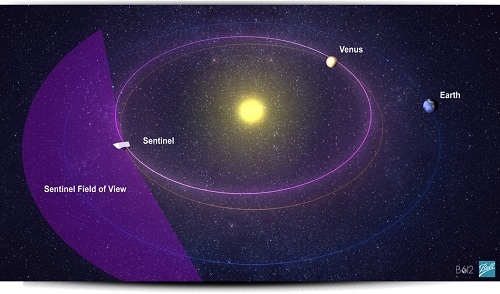
Image: Sentinel’s orbit and field of view. Credit: B612 Foundation.
The organization is saying that in its first weeks of operation, Sentinel will surpass the total of Earth-crossing asteroids catalogued in all previous efforts, and in five years of operation, relaying data to the Deep Space Network, it will track 100 times more asteroids than have been found by all other telescopes combined. The infrared space telescope is being developed at Ball Aerospace by the same team that developed the Spitzer and Kepler space telescopes, with launch aboard a SpaceX Falcon 9 currently planned for 2017-2018. The mission will perform a gravitational slingshot maneuver around Venus before settling into its final orbit around the Sun.
As we enter the age of commercial spaceflight, we can look back to the scientists, engineers and astronauts who made missions like these possible. It would be interesting to know whether Eric Burgess or C. A. Cross would have assumed probes like the ones descended from their model would emerge out of government or from private funding — we can remember the commercial streak in much science fiction of the era, like Heinlein’s “The Man Who Sold the Moon” (1950) in which the first lunar expedition is mounted by a businessman. Whatever the case, their probe ideas continue to resonate as private money now turns to deep space.






September 19, 2012
Wrapping Up the Houston Starship
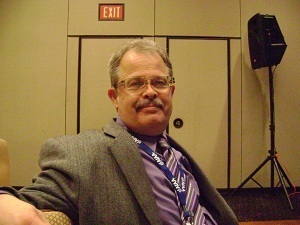
Because I utterly lack their skills, I have huge admiration for practical-minded people who can organize things well. Eric Davis’ work as track chair for the ‘Time and Distance Solutions’ track in Houston is a case in point. The challenge is in coping with a key fact of interstellar studies: We are so early in the game that we have not remotely figured out which propulsion method makes the most sense for journeys of this magnitude. Discussing time and distance means culling papers to find a balance of ideas, from what could be near-term (fusion, although it always seems near-term) to highly speculative (antimatter and nanotech).
Image: Physicist Eric Davis, a highly visible figure at the Houston conference.
Eric nailed the composition of the track, and it was because of that that I stayed in it through the conference. The temptation of getting involved with alternate tracks on ‘Becoming an Interstellar Civilization’ and especially ‘Destinations and Habitats’ was huge, but it was the time and distance problem that first drew me to interstellar studies so that is where I stayed. I’m hoping that Eric as well as several other track chairs will be able to offer their thoughts in future Centauri Dreams articles on how their sessions went.
Sleepless in Houston
Mae Jemison, who runs the 100 Year Starship organization, was everywhere, and I was beginning to wonder if she ever slept. She was in meetings all day Wednesday with the advisory council and later the track chairs, then in constant motion afterwards, a highly visible figure who never seemed to run out of energy. Gordon Gould and I asked her at lunch on Thursday about her flight aboard Endeavour in 1992, curious about what it is like to actually be blasted into space. We’ve all seen Shuttle launches and know how impressive, noisy and fearsome they can be.
But Mae said the effect was actually quite different. “You’re so wrapped up in padding and shielded from the noise that from inside, it’s just like being in the simulator. Remember that you have to hear all the communications inside the craft, so the noise seems very far away.” I had the same reaction a few months back when I asked Shuttle astronaut Drew Feistel, a veteran of Hubble Space Telescope repairs, whether that sweeping roll the Shuttle used to perform on liftoff was as dramatic from inside as it appeared to spectators. And the answer was no. Drew said you mostly felt acceleration, and that the roll maneuver felt very gradual and unobtrusive.
The job ahead of Mae’s group is, of course, enormous, and a huge part of that job will be to connect to a public that is both hamstrung by economic concerns and largely out of the kind of space mode we saw back in the Apollo days. My thought on that is that an organization like the 100 Year Starship can do a world of good by helping to get the word out about what interstellar issues really are. It’s surprising how few people realize the distances we’re talking about — when I first arrived in Houston, I cited in these pages the person who had emailed me with the question: “We’re already going to Pluto. How much harder can it be to go to a star?”
I gave a flip answer to that question in my earlier post, but it’s indicative of the mind-boggling nature of the time and distance conundrum and how little it is perceived by the public. I think we need to communicate how enormously challenging it will be to go to the stars at the same time that we provide a sound rationale for methodically looking at the problem. It is not using scare tactics to suggest that Earth’s history has been violent and that asteroid or comet impacts are not necessarily all in the past. And it is not being overly sanguine to say that the kind of solutions that will enable a crewed starship — maintaining sound ecologies, for example — are solutions that will have resonance on our own green planet and will help us to preserve it.
Spinoffs are always a touchy subject in spaceflight terms because they’re so easily ridiculed, and the average citizen is more likely to think of Tang than of GPS as a result of space research. But this is simply a hurdle that must be cleared for an organization with a 100-year mission to succeed. Learning how to propel a payload at a small percentage of lightspeed could have enormous ramifications for our production and use of energy on Earth, while the demand for autonomous systems will propel us into major advances in artificial intelligence and robotics. As one speaker noted, whether manned or not, a starship will demand autonomous systems.
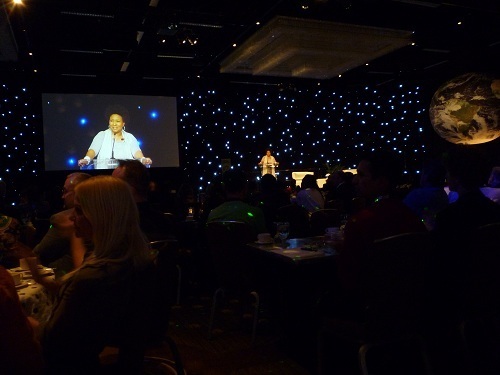
Image: Mae Jemison addresses the crowd at Saturday night’s gala.
Into the Cosmic Sea
Let me close my Houston coverage with some thoughts about Jill Tarter. The SETI legend spoke to the symposium at large on Saturday in a short, inspiring talk outlining the search for Earth 2.0. We have yet to detect proof of an extraterrestrial civilization after 50 years of searching, but Tarter is doubling down on the need to keep looking given the small sample in our searches:
“Think about an Earth ocean as an analog. We’ve sampled the equivalent of one eight ounce glass out of that ocean in 50 years. Now you might get lucky and scoop up a fish when you do something like that, but chances are you wouldn’t. So our sample is small, inadequate. A cosmic ocean is out there beckoning us — the monumental task of sampling it remains… Our search must be audacious and inclusive. SETI trivializes the differences among us, and if it does nothing but expose every human being on the planet to this perspective, it will still have been one of the most significant events in human history.”
What might we pick up? Tarter said we will discover that Earth 2.0 in short order, meaning an Earth-mass planet in the habitable zone of a Sun-like star, but added that for it to truly be Earth 2.0, it will need to be inhabited. A technology we might detect could be anything from a beacon to a vast communications network, or perhaps huge shields against asteroid impacts or a completely unforeseen technology that could be generating radio or optical signals. “If we find technology, we can infer intelligence,” she added. “We can’t directly detect intelligence.”
Tarter’s message resonated with a crowd that, like her, believes we are a very young technology in a very old galaxy. A key question: Is it possible for a technological civilization to last for cosmic lengths of time? If the answer is no, Tarter believes SETI will fail, but of course we all hope the answer is yes. It was Philip Morrison, co-author of the first major paper on SETI, who called the idea “the archaeology of the future.” Sifting through the faint signals that impinge upon our dishes from the galaxy around us, we hope, unlike archaeologists, to find not just enigmatic remains but a living presence whose very existence will add meaning to our place in the cosmos.
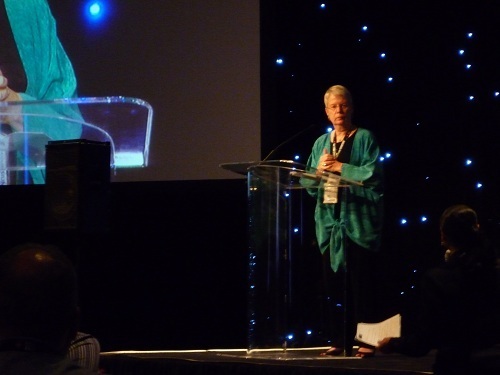
In going forward, both in SETI and in the 100 Year Starship initiative, I’m reminded of Mae Jemison’s quote from Bashō, the greatest poet of the Edo period in Japan. Bashō’s wanderings into unknown country made him a legend, giving him material for his work and renewed purpose. He had learned from experience the lesson he conveyed here: “Seek not to follow in the footsteps of men of old; seek what they sought.”






September 18, 2012
A Lab Experiment to Test Spacetime Distortion
Sonny White’s work on exotic propulsion has galvanized the press, as witness this story in the Daily Mail, one of many articles in newspapers and online venues. I was fortunate enough to be in the sessions at the 100 Year Starship Symposium where White, an engaging and affable speaker, described what his team at Eagleworks Laboratories (Johnson Space Center) is doing. The issue at hand is whether a so-called ‘warp drive’ that distorts spacetime itself is possible given the vast amounts of energy it demands. White’s team believes the energy problem may not be as severe as originally thought.
Here I’ll quote Richard Obousy, head of Icarus Interstellar, who told Clara Moskowitz in Space.com: “Everything within space is restricted by the speed of light. But the really cool thing is space-time, the fabric of space, is not limited by the speed of light.”
On that idea hangs the warp drive. Physicists Michael Pfenning and Larry Ford went to work on Miguel Alcubierre’s 1994 paper, the first to examine the distortion of spacetime as a driver for a spacecraft, to discover that such a drive would demand amounts of energy beyond anything available in the known universe. And that was only the beginning. Alcubierre’s work demanded positive energy to contract spacetime in front of the vessel and negative energy to expand spacetime behind it. Given that we do not know whether negative energies densities can exist, much less be manipulated by humans, the work remained completely theoretical.
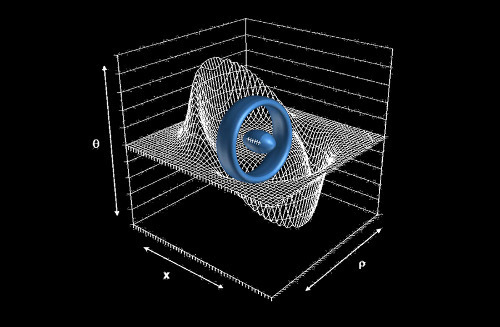
Image: A starship (in the center of the ring) taking advantage of the distortion of spacetime. Credit: Harold White.
But interesting things have developed since the original Alcubierre paper. Running quickly through what White told the Houston audience, Chris van Den Broeck was able to reduce the energy costs of a warp drive significantly and other theorists have continued to drop the numbers. White’s team has been examining ways to continue that progression, but what is eye-catching is that he is working on a laboratory experiment to “perturb spacetime by one part in ten million” using an instrument called the White-Juday Warp Field Interferometer to create the minute spacetime disruption.
I know of no teams other than White’s who are looking at lab work that could tell us whether a perturbation of spacetime can actually be created. From a NASA document on this work:
Across 1cm, the experimental rig should be able to measure space perturbations down to ~1 part in 10,000,000. As previously discussed, the canonical form of the metric suggests that boost may be the driving phenomenon in the process of physically establishing the phenomenon in a lab. Further, the energy density character over a number of shell thicknesses suggests that a toroidal donut of boost can establish the spherical region. Based on the expected sensitivity of the rig, a 1cm diameter toroidal test article (something as simple as a very high-voltage capacitor ring) with a boost on the order of 1.0000001 is necessary to generate an effect that can be effectively detected by the apparatus. The intensity and spatial distribution of the phenomenon can be quantified using 2D analytic signal techniques comparing the detected interferometer fringe plot with the test device off with the detected plot with the device energized.
So it’s interesting stuff, and it takes us to an even lower energy requirement, from the mass-energy of a planet the size of Jupiter to, in White’s view, a mass about the size of one of our Voyager probes. The reduction in the exotic matter/negative pressure required is managed by optimizing the warp bubble thickness and also by oscillating the bubble intensity, which according to White’s mathematics reduces the stiffness of spacetime. Thus we go from a Jupiter-sized portion of exotic matter to an amount weighing less than 500 kg.
White said the test was an attempt to prove that spacetime perturbation is possible, and likened it to a ‘Chicago pile moment.’ It was in 1942 that the first demonstration of a controlled nuclear reaction produced just half a watt of power, but a year later a four megawatt reactor was already in operation. With no tidal forces inside the warp bubble and a proper acceleration of zero, a future craft would be an undemanding platform in which to travel, and White pointed out that clocks aboard the spacecraft would move at the same rate as clocks back on Earth. It’s an exotic idea, but one that White’s lab testbed will now poke and prod to see if it’s possible.
Addendum: Al Jackson just sent me an email about other matters, but it includes a portion that’s specifically related to the above topic that I want to quote:
“I did my doctorial stuff in General Relativity. When I was in Austin for Armadillocon, last August, I asked my adviser, Richard Matzner, about the Alcubierre deal, since Richard does a lot of numerical GR he knows Alcubierre (who is an ace numerical GR guy), says he never heard him talk about his warp drive. Richard is not much interested in it either, thinks the solution is Lyapunov unstable. I have seen some works from Italy about Alcubierre and other ‘exotic matter’ warp solutions that show the models are unstable. Richard said he thinks Kip Thorne is no longer interested in it. I have never seen a really ‘heavy hitter’ like Hawking or Thorne, or a whole lot of other first string GR theorists ever remark on Alcubierre or the other recent solutions. There was a ‘name’ relativistist, William A. Hiscock, who did, he felt the solutions were not physical, but he thought people should keep trying. Alas that guy died young, only a few years ago.
But it is interesting that these solutions exist. I think, it’s going to take more imagination and further discoveries before something can be made of this.”






Paul Gilster's Blog
- Paul Gilster's profile
- 7 followers



